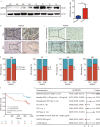ADP-dependent glucokinase controls metabolic fitness in prostate cancer progression
- PMID: 38082365
- PMCID: PMC10714548
- DOI: 10.1186/s40779-023-00500-9
ADP-dependent glucokinase controls metabolic fitness in prostate cancer progression
Abstract
Background: Cell metabolism plays a pivotal role in tumor progression, and targeting cancer metabolism might effectively kill cancer cells. We aimed to investigate the role of hexokinases in prostate cancer (PCa) and identify a crucial target for PCa treatment.
Methods: The Cancer Genome Atlas (TCGA) database, online tools and clinical samples were used to assess the expression and prognostic role of ADP-dependent glucokinase (ADPGK) in PCa. The effect of ADPGK expression on PCa cell malignant phenotypes was validated in vitro and in vivo. Quantitative proteomics, metabolomics, and extracellular acidification rate (ECAR) and oxygen consumption rate (OCR) tests were performed to evaluate the impact of ADPGK on PCa metabolism. The underlying mechanisms were explored through ADPGK overexpression and knockdown, co-immunoprecipitation (Co-IP), ECAR analysis and cell counting kit-8 (CCK-8) assays.
Results: ADPGK was the only glucokinase that was both upregulated and predicted worse overall survival (OS) in prostate adenocarcinoma (PRAD). Clinical sample analysis demonstrated that ADPGK was markedly upregulated in PCa tissues vs. non-PCa tissues. High ADPGK expression indicates worse survival outcomes, and ADPGK serves as an independent factor of biochemical recurrence. In vitro and in vivo experiments showed that ADPGK overexpression promoted PCa cell proliferation and migration, and ADPGK inhibition suppressed malignant phenotypes. Metabolomics, proteomics, and ECAR and OCR tests revealed that ADPGK significantly accelerated glycolysis in PCa. Mechanistically, ADPGK binds aldolase C (ALDOC) to promote glycolysis via AMP-activated protein kinase (AMPK) phosphorylation. ALDOC was positively correlated with ADPGK, and high ALDOC expression was associated with worse survival outcomes in PCa.
Conclusions: In summary, ADPGK is a driving factor in PCa progression, and its high expression contributes to a poor prognosis in PCa patients. ADPGK accelerates PCa glycolysis and progression by activating ALDOC-AMPK signaling, suggesting that ADPGK might be an effective target and marker for PCa treatment and prognosis evaluation.
Keywords: ADP-dependent glucokinase (ADPGK); AMPK; Aldolase C (ALDOC); Glycolysis; Prostate cancer (PCa).
© 2023. The Author(s).
Conflict of interest statement
The authors declare that they have no competing interests.
Figures








Comment in
-
ADP-dependent glucokinase: the ancient, archaeal key to prostate cancer.Mil Med Res. 2024 Feb 12;11(1):10. doi: 10.1186/s40779-024-00514-x. Mil Med Res. 2024. PMID: 38342920 Free PMC article. No abstract available.
-
Emerging roles of ADP-dependent glucokinase in prostate cancer.Mil Med Res. 2024 Feb 27;11(1):15. doi: 10.1186/s40779-024-00518-7. Mil Med Res. 2024. PMID: 38409104 Free PMC article. No abstract available.
References
-
- Mottet N, van den Bergh RCN, Briers E, Van den Broeck T, Cumberbatch MG, De Santis M, et al. EAU-EANM-ESTRO-ESUR-SIOG Guidelines on Prostate Cancer-2020 Update Part 1: screening, diagnosis, and local treatment with curative intent. Eur Urol. 2021;79(2):243–62. doi: 10.1016/j.eururo.2020.09.042. - DOI - PubMed
Publication types
MeSH terms
Substances
Grants and funding
LinkOut - more resources
Full Text Sources
Medical
Miscellaneous

